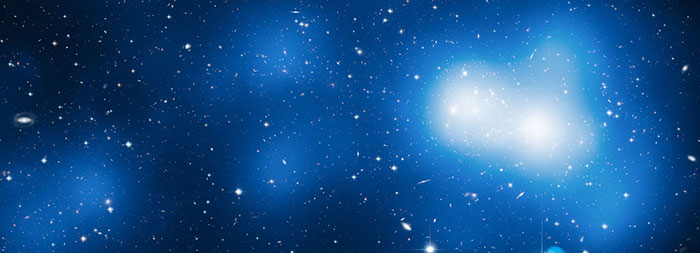Better Not Avoid A Cosmic Void

ESA/Hubble | http://bit.ly/1lNTDHA
(Inside Science) -- Sometimes nothingness can reveal a whole lot.
While the universe is mostly empty, it contains bubble-like voids that are even emptier, taking up most of the space in the cosmos. And new research shows that these voids all look similar regardless of size — a consistency that may help unravel some of the universe's biggest mysteries.
If you zoom way out, all the matter in the universe looks like a huge cobweb, consisting of an expansive network of filaments and wall-like structures that crisscross one another.
More than 80 percent of this matter is dark matter, the invisible and mysterious stuff that appears to interact only gravitationally with the regular matter that makes up stars and galaxies. Residing in these filaments and walls of dark matter are galaxies, and the densest regions — where the filaments intersect — are sites of massive clusters of hundreds to thousands of galaxies.
But between the filaments and walls of this cosmic web are vast cosmic voids. There are stray galaxies here and there, but overall, these bubble-like voids are about 80 percent less dense than the cosmic average. There can even be voids within a void, producing a nested structure.
Voids may be filled with nothingness, but researchers are now realizing that these empty spaces may actually contain clues for solving cosmic riddles like the nature of dark matter and dark energy, the puzzling force that's accelerating the expansion of the cosmos.
"Normally people look for the presence of something — and that's very important," said Joseph Silk of the Paris Institute of Astrophysics. "But sometimes it's also important to measure the absence of something. The absence of galaxies is just another way of looking at the universe."
Astronomers discovered cosmic voids along with the cosmic web in the late 1970s. Since then, most of the focus has been on studying the cosmic web itself. But that's been changing over the last few years, said Rien van de Weijgaert of the University of Groningen in the Netherlands.
Prompted by the discovery of dark energy, more astronomers are exploring these voids. They have combined recent observations that map the three-dimensional distribution of hundreds of millions of galaxies with increasingly better computer simulations.
"There has been an explosion of interest," van de Weijgaert said.
A new study now shows that, on average, voids have similar features regardless of their size. A team of astronomers led by Nico Hamaus of the Paris Institute of Astrophysics used a computer simulation to generate tens of thousands of cosmic voids, which were then analyzed to devise a model that describes their average characteristics.
Voids do contain small amounts of mass, and the model describes how this mass is distributed within them. The density is lowest at the center and increases farther out — reaching a maximum where the matter becomes part of the cosmic web — before dropping off again. According to the analysis, this model can be applied to all cosmic voids.
"I was surprised by the simplicity and universality of this simple prescription to model the voids," Hamaus said. The study was published in the June 27 issue of Physical Review Letters.
Other researchers have developed similar descriptions of voids, but the new study takes it a step further by generalizing the findings to all voids, van de Weijgaert said. And that means voids can serve as a powerful tool for probing dark energy.
"That's the hope," Hamaus said. "We haven't proven this yet, but we have a feeling that [this model] could be useful."
Dark energy is thought to be a kind of constant energy that's embedded within the vacuum of the universe. Because voids are so empty — and thus contain minimal gravity, for instance — the effects of dark energy should dominate, making these empty bubbles a pristine place to study the mysterious force.
The fact that voids seem to have consistent features means researchers can apply the model to observations of not just one or two voids, but as many as they can measure. By comparing the model to observations, researchers can then test theories of dark energy.
Some astronomers have even suggested that studying cosmic voids could be the most accurate technique yet for measuring dark energy, van de Weijgaert said.
The new model, Silk added, could also be a tool for testing theories of cosmic inflation — the idea that the universe expanded extremely rapidly within the first moments after the Big Bang. According to theory, the pre-inflationary universe contained tiny, random fluctuations. Thanks to inflation, these fluctuations ballooned to eventually become the voids, filaments, and walls of the cosmic web.
Theory predicts that because the fluctuations were random, there should be a similar number of regions of high density as there are regions of low density. The new model can help predict if this is really the case, Silk said.
As for why cosmic voids would all be so similar in the first place, no one's sure yet, according to van de Weijgaert. But, he suggests that it's likely related to the fact that the density fluctuations in the early universe were fairly uniform.
There's a lot more to learn about cosmic voids and what they may reveal about the universe, he said. "It's certainly not the end of the story."

